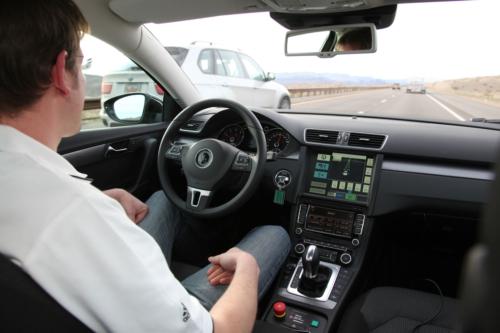Continental, a leading global automotive supplier, today received approval from the Nevada Department of Motor Vehicles (DMV) to test autonomous vehicles on the state’s public roads. Continental’s testing license is for the company’s highly automated vehicle, and represents the first license granted by the Nevada DMV to an automotive supplier.
“At Continental, we continue to invest in research and development for next generation technologies – such as our highly automated vehicle – that will drive us toward a safer, more efficient and more comfortable future,” said Dr. Elmar Degenhart, chairman of the executive board of Continental. “As a company, Continental’s strategy is clearly focused on making this type of future technology a reality. It’s clear to us that automated driving will be a key element in the mobility of the future. As a system supplier, we are perfectly positioned to develop and launch series production of solutions for partially automated systems for our customers by 2016. We will be able to develop the first applications for highly and ultimately fully automated driving, even at higher speeds and in more complex driving situations, ready for production by 2020 or 2025.”
After completing driving demonstrations on December 18 in Carson City, the DMV’s Autonomous Review Committee approved Continental’s safety plans, employee training, system functions and accident reporting mechanisms.
Following approvals, Continental will receive its testing license and red license plate featuring an infinity sign to represent the car of the future. The plate is designed to be easily recognized by law enforcement and the public at large. It will only be used for licensed autonomous test vehicles.
“Earning this license represents an important intermediate step towards automated driving for Continental,” said Christian Schumacher, Head of Continental’s Advanced Driver Assistance Systems (ADAS) Business Unit in NAFTA. “Continuing our research and testing in the most challenging environment – public roads — under the highest safety standards, will allow us to continue to assess and develop our highly automated vehicle. This vehicle demonstrates what modern technology can do to provide a safer, more comfortable drive.”
“We are proud that our state is serving as the platform for automated testing and licensing. Nevada’s steady climate, varying terrains and driving conditions offer an excellent opportunity for more companies, especially automotive organizations, to take advantage of this autonomous driving opportunity,” said Troy L. Dillard, Director Nevada Department of Motor Vehicles. “Automated vehicles, such as the one Continental is testing, illustrate the extensive research and development occurring within the automotive industry and embody the future of a vehicle equipped to make the driving experience safer and more enjoyable.”
Continental’s current highly automated vehicle is designed to always have a driver monitoring the vehicle behind the wheel, unlike a completely automated vehicle. Designed as a driver assist system, the automated vehicle can accommodate multiple driving scenarios. Utilizing four short-range radar sensors (two at the front, two at the rear), one long-range radar and a stereo camera, the vehicle is capable of cruising down an open freeway as well as negotiating heavy rush-hour traffic. Taking advantage of Continental’s sensor fusion technology as part of the ContiGuard safety concept, the vehicle is able to track all objects as they enter into the sensors’ field of view. The object information is then processed and passed on to the Continental Motion Domain Controller to control the vehicle’s longitudinal and lateral motion via signals to the engine, the brakes and the steering system.
The equipment in Continental’s highly automated vehicle differs from the customized sensors and tailor-made actuators in other automated vehicles. The vehicle, which has logged more than 15,000 miles, is built primarily with equipment that is already available in series production. Continental’s short term goal is to relieve the driver of tedious and monotonous activities, such as driving on highways with minimal traffic or in low-speed situations like traffic jams.
Although the concept of complete autonomous driving is valid, it is not yet fully viable. Continental’s highly automated vehicle, however, is an intermediate step toward autonomous driving. Continental’s vehicle brings us closer to achieving the company’s Vision Zero – the goal of reaching zero accidents and zero fatalities on the roadways.
Continental will continue real world evaluations with this vehicle and believes that a highly automated driving vehicle featuring traffic jam assist will be introduced within the next few years.


